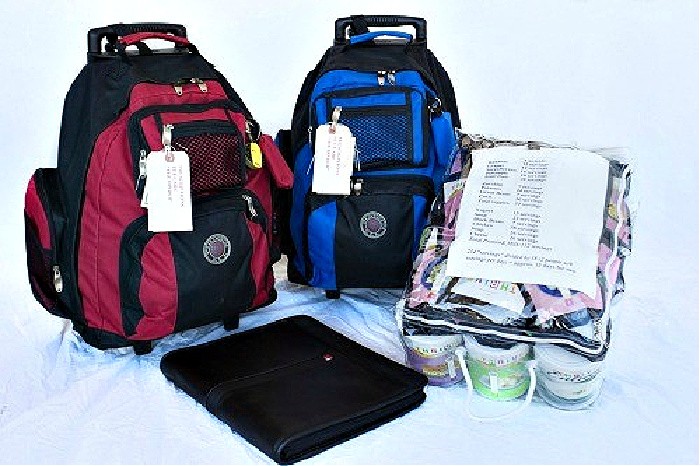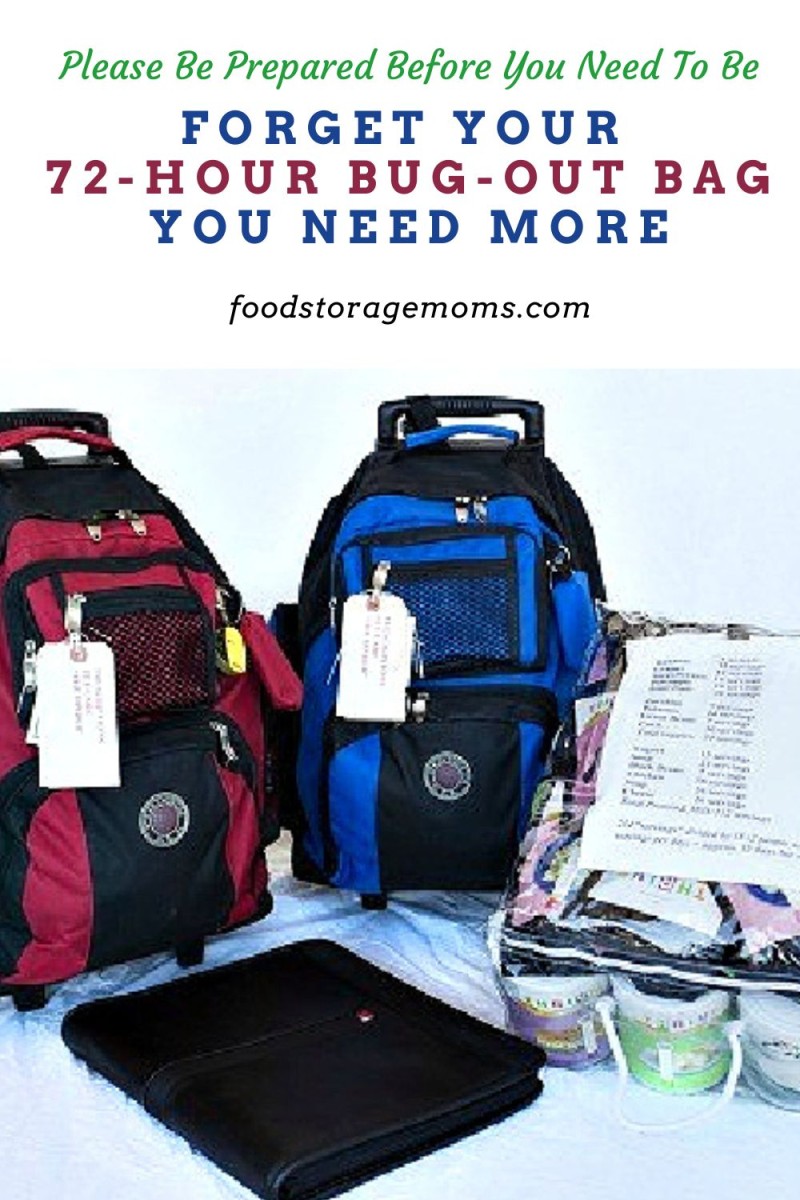
Forget your 72-hour bug-out bag you need more. For those who may be new to the preparedness game, we have all been primed to have at least 72- hours’ worth of items necessary to make it through a disaster or event of an emergency. This stash of items has been called by a number of names, including preparedness kit, emergency preparedness kit, 72-hour kit, emergency kit, survival kit, disaster supplies kit, and bug-out bag.
How this stash is prepared and packed can take on a life of its own. A lot depends on how many items are actually included, their size, and if they need any special treatment when being put together. In most cases that I’ve seen, people will use a backpack or large duffle bag. It isn’t designed to include everything for the whole family. There should be a bag or kit for each member, including one for the little ones even if they can’t be the carrier of their own.
Although they could be used in a “shelter-in-place” scenario, they are usually put together so they can be quickly grabbed on your way out of the house. What we used to think was acceptable in a 72-hour bug-out bag or kit was okay, but over the years I’ve learned there are additional items needed to get you through. Before anyone gets too excited let me explain my thinking.
In case you missed this post, 11 Canned Meat Ideas I Recommend
What is really necessary for a 72-hour kit?
In the last 15-20 years, I think a 72-hour bug-out bag or kit was the thing we all did. Well, we need to up our game, my friends. I’ve been looking online at some groups who have a list of maybe 20 items and it all fits in a gallon container. No water. WHAT? They called this little unit a 72-hour kit! Crazy, huh?
Yep, that’s what I said. I looked at some items on the list that filled the gallon jug with a handle. I wouldn’t eat 99% of the food items on the list. If I was starving, of course, I would have to eat it, right? But I would be so thirsty from all the sodium and just need more to stay hydrated!
Okay, let’s get real here. If we have a disaster we will for sure need more critical items than 72 hours’ worth of food, water, etc. When I would pass out my suggested list of emergency items for a 72-hour bug-out bag to classes I would teach, people would just shake their heads like I was the crazy one.
Shout Out To Truck Drivers/Railroad Employees
I would joke that my list required a semi-truck. Just kidding, of course. By the way, we need to give a HUGE shout-out to our truckers and railroad employees who work 24/7 and work almost all holidays to bring us food, paper products, gasoline, and everything we see in our fabulous supermarkets, gas stations, hospitals, and more. Thank you!! Our current lifestyles would take a real hit if the truckers and railroad workers didn’t do their part to make our economy what it is today.
Here’s my list with many of them just basic items. Pick and choose the items you can’t do without in say 30 days. We certainly can’t have all these items if we expect to make them reasonably portable, but you should plan a fair amount or you could find yourself lacking what is needed. We need to step out of the 72-96 hour bug-out bag or kit right now. That amount of time is no longer realistic. Trust me, look at the news and you will see for yourself.
People are stranded a lot longer than that amount of time from different situations we see all over the country. Please don’t count on the government, they may not reach you for days or weeks.
It would help if you were prepared for the unexpected today, not tomorrow.

Bug Out Bag (you may need a trailer or you can bug in):
Every emergency agency in the country recommends having a 72-hour kit available to grab and go in an emergency. Be sure to update your kit every six months to a year, depending on the items you have in it and if the items need to be rotated like you do your regular storage items.
Include the food you know you will eat and items that can keep you busy during times of inactivity. Be mindful of storing items that might leak, melt, or affect other items in your bag if they do leak or break open (Ziploc bags might help with this problem).
Attach a tag to the kit or bag with your name, and phone number(s), a tag to remind you to grab your prescriptions/medicines, and a tag to grab your emergency binder. Depending on the needs of you and/or your family, items you could include in your kit are:
1. Water: at least three days supply (1-4 gallons per day per person), water purifiers, and water purifier bottles (like a Berkey Sports Portable Water Purifier) to last for at least three months.
2. MRE (Meals Ready to Eat): hot and cold ready-to-eat food packages; freeze-dried fruits and vegetables; and candy, gum, jerky, fruit snacks, raisins, fruit leather, granola bars, peanuts, crackers, etc.
3. Over-the-Counter Medications: Aspirin, Aleve, Ibuprofen, Vitamin C, cold remedies, Essential Oils, etc., and antacids (for upset stomachs) Don’t forget Tylenol PM or something similar to use as a sleeping aid.
4. Ax/shovel combo: in case you need to cut and clear debris or snow
5. Baggies: (all sizes) can come in handy to store items or discard trash
6. Extra Batteries: (all sizes-rotate yearly)
7. Bible/Scriptures/Games: you may be faced with more free time than you think
8. Bee sting & bite kit: you may have to set up camp in the out of doors
9. Blanket: (solar versions are thinner) may need it to stay warm day or night – also consider a sleeping bag
10. Pillow:
11. Bleach: (household chlorine–nonscented) could be used to clean and sanitize, but also treat water
12. Books: may need them to pass time, but also stay informed
13. Bung wrench/Gas shut-off wrench: use caution if there may be a gas leak and you’ll need the utility to turn the gas back on
14. CASH-small bills/coins: (if we lose power, ATMs won’t work; credit/debit cards won’t work)
15. Manual Can Opener: (non-electric) power may not be available
16. Canned stove: for outside use when cooking or keeping foods hot
17. Candles/glow sticks: for light and possibly to heat a small area – be cautious
18. Face Cards, toys, or small games to play:
19. Chapstick/lip balm: you may be outside for extended periods
20. Chargers: in case we have electricity
21. Coats/Jackets/Sweaters/Extra Change of Clothes & Shoes:
22. Coffee Pot, pitcher, and drinking portable container:
23. Cooking pot, griddle, or frying pan:
24. Cooking stove: chose some kind with the needed fuel, a firestarter or striker
25. Compass:
26. Contact lenses & supplies:
27. Cotton Swabs/Kleenex Tissues:
28. Disinfectant:
29. Duct tape:
30. Emergency sewing kit:
31. Fingernail clippers/nail file:
32. Fire extinguisher:
33. First-Aid Kit:
34. Hand Warmers:
35. Flashlights: (preferably solar or crank); don’t forget batteries (store batteries outside the flashlights to keep them fresh)
36. Garbage Bags:
37. Glasses: (extra pair of eyeglasses)
38. Gloves: latex or non-latex
39. Hair brushes/combs:
40. Hats, warm gloves, & scarves:
41. Headlamp:
42. Hearing Aids: plus spare batteries
43. Imodium/Anti-Diarrhea medicine:
44. Instant milk: (chocolate milk would be good as well)
45. Ipecac: (check with poison control if possible)
46. Hot pads, dish towels/rags/dish soap:
47. Lanterns/compact lights:
48. Hand Crank NOAA Weather Radio:
49. Masks N-95: minimum protection – consider dust masks too
50. Matches: consider a waterproof container too
51. Mess Kits:
52. Mirror:
53. Scissors:
54. All-Purpose Knife:
55. Mosquito Spray:
56. Personal Hygiene items: tampons, pads, feminine supplies, moist towelettes
57. Post-It Notes: pencil, pen, crayons
58. Plastic Sheeting: also plastic ties
59. Rain Poncho:
60. Rope:
61. Safety pins: several sizes
62. Shaving cream & shavers: (disposable)
63. Solar lights:
64. Sunglasses:
65. Temporary toilet and bags:
66. Thermal Underwear:
67. Thermometer:
68. Personal Sanitation: Toilet Paper, shampoo, hand soap, baby wipes, hand sanitizer, deodorant, toothbrushes, toothpaste, tweezers, & paper towels
69. Tools:
70. Tent(s):
71. Umbrella:
72. Utensils, plates, cups, and silverware: to cook and eat with
73. Vaseline:
74. Wet wipes: lots…they might be your only shower
75. Whistle & Walkie Talkies: (test before you need them for distance) like Motorola Talkabout 2-Way Radios
76. Baby Needs: diapers, infant formula
77. Work Gloves: grab socks, shoes, boots, and dryable clothing
Additional Items to Consider:
- Items for Pets: food, leash, winter coat
- Local Maps
- Cell phones
- Important family documents: bank account records, insurance policies, personal identification, birth & death certificates, doctor and dentist information, medical records, etc.
Final Word
Remember, you would need a truck to “haul” all of these items, so check off one item at a time and pick the items that meet your family’s needs. These are IDEAS, just start collecting a little at a time.
Put all the things that need to be rotated together in baggies. This way you GRAB a bag and switch out the outdated items.
Please remember my book is available: Prepare Your Family for Survival. May God bless this world. Linda
FEMA: FEMA-Food and Water in an Emergency
The post Forget Your 72-Hour Bug-Out Bag You Need More appeared first on Food Storage Moms.
